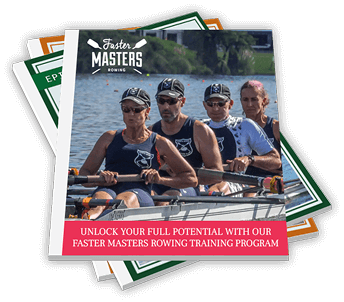Rowing a quad, four or an eight? To get good speed and rhythm, you must have good finishes.
Timestamps
00:45 Finishes for big boats
You row them differently than small boats. Finish together - all the oars come out of the water at the same time. Is everyone exactly in time? If not, look at what people are doing with the handle - what happens in the water is directly affected by what is happening on the handle. Some athletes may be dragging their handles downwards to take the oars out of the water.
Big boats move fast and this is one of the reasons why big boats are rowed differently than small boats. If you take the pressure off the tip of the spoon early the mound of water in front of the blade and the pocket behind the blade start to equalise. The water quickly starts to equalise in height and you may feel it's harder to get the oar out of the water. Keep pressure on the face of the blade is key to enabling a smooth extraction.
03:30 Dragging the blade
Signs you may be dragging at the blade end - if the bottom edge flicks water as it comes out at the finish. Also you may be feathering the blade out of the water - if it turns in order to extract rather than extracting first and then turns in the air. If your oar is close to the surface after the finish this may be a sign that you're dragging the blade out. It should be cleanly extracted and move high above the water surface before you feather.
04:45 Improve finishes
Try square blade rowing. This is a discipline which is rewarded in the long term as it helps you fix blade dragging and getting the oar out of the water cleanly. Before starting, check when sitting stationary that your foot stretcher is set up correctly (all port side oars are parallel). Back of the seat back wheel is 58-62 cm behind the face of the pin [ask us if you don't know what this is].
When rowing square blades it's important to know where your handle should be at the finish before extraction. In sweep the outside hand position is key and in sculling, the gap between your handles if the key measure.
3 focus points to try in the boat
- hold onto the finish 1cm longer than before
- helps the acceleration and holding the oar under the water
- square blade rowing
07:00 Boat not level
It's hard to do a good finish if the boat isn't level at the finish. Check your handle position at the finish when the boat is stationary to find where the correct place is. In sweep, check your outside elbow is pointing behind you and your inside forearm is at approx. 90 degrees to the oar shaft at the finish.
Outside arm should not be flared over the side of the boat because this inhibits your ability to control the handle height with your outside hand.
Remember inside hand square/feather and outside hand controls the handle height in sweep.
In both sweep and sculling if your elbow is lower than your wrist it's hard to put downward pressure on the handle and is a sign you are rigged too high and need to adjust.
08:30 Square blade rowing
When rowing square blades the height differences show up when the boat isn't level. The level finish and square blade rowing work together - if one is off the other is likely off as well. When the boat isn't level it shows up differences in your finish timing and also handle heights. Go back and fix these first as a means to improving your square blade rowing.
Further resources
- Square Blade Challenge - Coaching Camp [3 lessons]
- Finishes for sweep - podcast [15 minutes]
- Hand placement for sweep & sculling - video [30 minutes]

